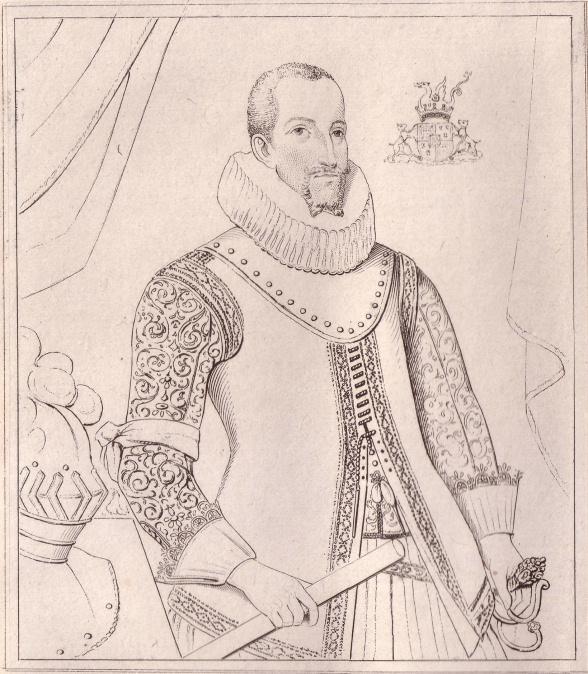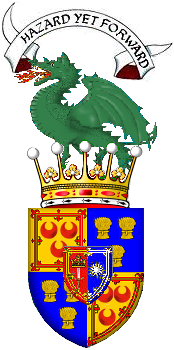Born in 1553,
he was granted by the Queen Regent a pension of £60 a year from Melrose Abbey, which gift was ratified, 17 April 1561. Styled "Master of Seton" after the death of his elder brother George, of whose baronies of Seton and Winton he had sasine, 20 February 1582, the first Earl of Winton grew up active in the affairs of his illustrious father, George 7th Lord Seton and of the State.Educated early in France, he accompanied his father during his ambassadorships to during the reign of Queen Mary. He was with his father in France, 1571, and Flanders in 1571, returning thence to Scotland shortly before 4 March 1573; had license, with his father to go abroad, on 27th June 1577; and accompanied the King from Stirling to Holyroodhouse, 29-30 September 1579.
Like his father, he was strongly attached to the family loyalty to the Queen and to the Royal House of Stuart; he was part of his father’s rescue party for Queen Mary at Lochleven and present during the battle of Langside thereafter, in 1568, though a youth, and grew up a close childhood friend of the Queen’s son, the young King James VI. As a result of their friendship, of course, he was part of the party who rescued King James from the hands of the Douglas’, and strongly supported his monarch during the Gowrie incident and all other incidents of the time.
On the death of his father, George, 7th Lord Seton, in 1585, Robert succeeded as 8th Lord Seton, and was served heir on 8 January 1585, and had sasine of the barony of Tranent, 28 January 1585. A supporter of the Roman Catholic party, he was made P.C. before 18 March 1585, and though omitted therefrom in 1587, he was re-appointed by King James VI on going to Denmark, 22 October 1589.
Although his father left the estates heavily encumbered by reason of the great expense of several embassies and of his losses suffered by adhering to the Queen’s party, yet by prudence and ability he was soon able to put his affairs in good condition and provide both sons and daughters with respectable fortunes.
He was a great favorite with the king, and exercised great hospitality at Seton where he frequently entertained James VI and his Queen, and noted that, “he was very hospitable, and kept a noble house, the King and Queen being frequently there, and all French and other ambassadors and strangers of quality were nobly entertained.” The list of Grand Balls and Masques would fill volumes; the great entertaining traditions he elaborated on from his father and grandfather, were passed to his own sons and heirs.
He was a great builder and a wise improver of his property, especially by working on the old harbor of Cockenzie along the Firth of Forth, a curious fishing village of the Lords Seton and of great antiquity whose history is little known or recorded. It originally sheltered only small boats, but when improved by art and accommodated vessels of a larger size.
As Lord Seton, Robert was present in Parliament from 4 December 1585; a Commissioner for clergy life-rents, 29 July 1587, of taxation, 18 January 1593/4, and to sit on Exchequer matters, 20 January 1594/5; attended the Coronation of Queen Anne at Holyroodhouse, 17 May 1590, and carried the basin at the baptism of Prince Henry in the Chapel Royal at Stirling, 30 August 1594; was a signatory of the pact against the Earl of Bothwell, 1 May, and on the assize for his trial, 10 August 1593; appointed to guard Edinburgh from the Nether Bow to the Market Cross on the King's return from Linlithgow, 1 January 1596; a Lord of the Articles, 11 November 1600; and was invested therewith "per cincturam gladii", on 23 or 26 December following, at or after the baptism of 3 December of Prince Charles, who was then created Duke of Albany.
In January, 1599, the king granted him a charter under the Great Seal of Scotland concerning Cockenzie, which had previously been erected into a “free port and burgh of barony.” Adhering to the Catholic religion, the Earl and his family suffered indignities from the Presbytery of Haddington, as may be seen by the Records, one entry reads thus: “1597. Setoun Kirk - The Presbitery asked Lord Setoun if he will suffer them to sit in the Kirk of Setoun for the space of two or three days, because they are to ‘gang about’ all the churches within their bounds; but this his Lordship altogether refused.”
For his long and untiring service and sacrifice and for that of his father and ancestors, Robert Seton, 8th Lord Seton was created 1st Earl of Winton (the creation being noted as with remainder to his Heirs-Male), in recognition of the informal title known to have been claimed by the family in the de Quincy Earldom of Winchester, and also that of Buchan, both never granted. The ceremony was proceeded with solemnity and pomp of banners, standards, and pennons, inscribed with loyal mottos and quaint devices at Holyrood House, on the 16th of November, 1600.
In 1582, Lord Seton, as he then was,
married on 19 May 1583 (the marital contract was dated the 10th April, 1582), Margaret , 1st daughter and (in 1612) heir of line of Hugh Montgomerie, 3rd Earl of Eglinton, by his 2nd wife, Agnes, daughter and coheir of Sir John DRUMMOND of Innerpeffray. Margaret's tocher being 10,000 merks, and by whom he had five sons and a daughter:1. Robert, second Earl of Winton.
2. George, third Earl of Winton.
3. Sir Alexander Seton of Foulstruther, Knight, who succeeded as sixth Earl of Eglinton, and in descent from whom is the present Earl of Eglinton and (later) Winton, Lord Montgomerie, Baron Ardrossan, Baron Seton and Tranent, etc.
4. Sir Thomas Seton, Baronet of Olivestob.
5. Sir John Seton, Baronet of St. Germains.
6. Lady Isabel Seton.
Robert Seton, 8th Lord Seton and 1st Earl of Winton died on the 22nd of March, 1603, and by his Latter Will, dated 28th February, 1603, he ordains “My body to be buried whole in most humble, quiet, modest, and Christian manner without all extraordinary pomp or unlawful ceremony, within my College Church of Seton among my progenitors of worthy memory.” By the words unlawful ceremony, the staunch old Catholic nobleman wished to say that he didn’t want any Protestant interference or Kirk rites about him after death, as he hadn’t "brooked them in life". Protestant worship has never been held in Seton Church, as after the family conformed they attended the Tranent parish church, leaving their own church deserted, as it has remained ever since.
He was buried on Tuesday, April 5th, on the same day that King James the Sixth of Scotland set out from Edinburgh for London to become James First of England. And now a singular thing happened, the more so that the simple tastes of the late Earl and his adhorrence of display at his funeral were suddenly upset. Patrick Frazer Tytler thus moralizes on the inauspicious occurrence in concluding his History of Scotland:
“As the monarch passed the house of Seton, near Musselburgh, he was met by the funeral of Lord Seton, a nobleman of high rank; which, with its solemn movement and sable trappings, occupied the road, and contrasted strangely and gloomily with the brilliant pageantry of the royal cavalcade. The Seton’s were one of the oldest and proudest families of Scotland; and that lord, whose mortal remains now passed by, had been a faithful adherent of the kings mother: whose banner he had never deserted, and in whose cause he had suffered exile and proscription. The meeting was thought ominous by the people.
It appeared, to their excited imaginations, as if the moment had arrived when the aristocracy of Scotland was about to merge in that of Great Britain; as if the Scottish nobles had finished their career of national glory, and this last representative of their race had been arrested on his road to the grave, to bid farewell to the last of Scotland’s kings. As the mourners moved slowly onward, the monarch himself, participating in these melancholy feelings, sat down by the way-side, on a stone still pointed out to the historical pilgrim; nor did he resume his progress till the gloomy procession had completely disappeared.”
The original line of the Lord's Seton was to have devolved upon the 2nd son of George, 7th Lord Seton, also called George, the Master of Seton. As the eldest son, the Master of Seton was greatly involved in his father's affairs and had been part of the events of Queen Mary's troubled reign, and that of the early years of her son, King James VI along with his immediate younger brother, Robert. It was only natural that he should succeed to the title and estates, however he died as a young man predeceasing his father, and his brother Robert became heir to the Seton Honours.
The 1st Earl of Winton's own son and heir, also Robert, became 2nd Earl of Winton, but resigned the title to his brother George, who became the celebrated 3rd Earl of Winton; and his 3rd son, Sir Alexander Seton of Foulstruther, succeeded as sixth Earl of Eglinton by right of descent from his mother Lady Margaret Montgomerie, and which arrangement was negotiated with the 5th Earl of Eglinton to continue the line in bearing the name of Montgomerie, and in descent from whom is the present Earl of Eglinton and Winton, Lord Montgomerie, Ardrossan, Baron Seton and Tranent, etc. The Eglinton settlement was overseen personally by King James VI and I, who although opposed initially, later consented on the condition that the Sir Alexander and his heirs adopt the name of Montgomerie, forever to be known as Montgomerie and never again as Seton.
The widow of the 1sy Earl of Winton then, Margaret Montgomerie,the Countess of Winton, died herself on the 9th April 1624, at Seton.





